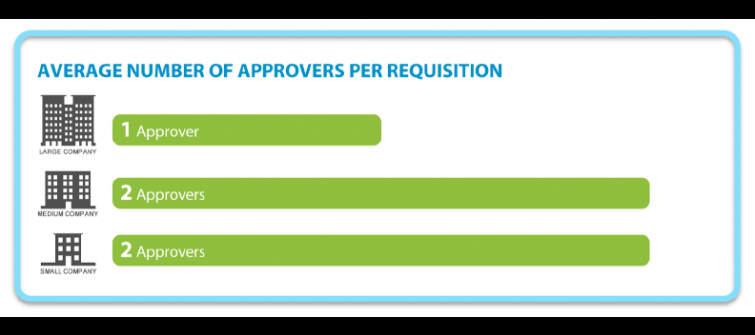Coupa Benchmark: Number of Approvers Per Requisition

Through the Coupa cloud platform, we track hundreds of metrics to help us continually improve our platform and help our customers be successful.
The annual Coupa Benchmark Report is designed companies by sharing data on some of these key finance and procurement performance indicators. The Benchmark includes metrics about ten critical areas where we commonly find that companies do not know how good they can be. Over the coming weeks, we'll be sharing these with you in depth.
Today's featured benchmark is number of approvers per requisition.
According to our data, the biggest companies, those larger than $1.5 billion in revenue, averaged one approver per requsition. Mid-size companies (those between $250 million and $1.5 billion) and small companies (those with under $250 million in revenues) averaged two approvers per requisition.
More Approvers Isn't Always Better
Contrary to popular belief, increasing the number of approvers does not always result in more effective spend control. More often, adding approvers hinders the process by delaying the time it takes employees to get approval for the goods and services they need to get their jobs done.
Having many approvers may also indicate a highly bureaucratic environment, which reduces individual accountability. When there are many approvers, people assume that the others are doing due diligence and simply approve without much thought.
What's the Right Number of Approvers?
Take a good look at your approvers. Most importantly, look at the number of rejections by each. If the approver is not rejecting any requisitions, odds are they aren’t providing any spend governance or adding value in the approval chain. You should also inspect your approval chains to ensure there are no legacy approvers in the loop.
Review your processes. Organizations often have legacy approval workflows because of audit documentation that dictated the approval levels. Take the time to review and update audit documentation to streamline processes. Don’t assume that a process that was necessary a few years ago is still valid today.
Define and implement dynamic approval workflows that change based on the characteristics of the requisition – such as what’s being bought and how much is being spent – not just who is doing the buying. Having the wrong people in an approval chain reduces accountability.
Make sure that you can easily change approval workflow based on your changing needs and employee turnover. Fewer approvers means greater accountability and faster processing.
About The Coupa Benchmark
This data was extrapolated from customer usage metrics on the Coupa cloud platform, comprising hundreds of thousands of global users, over 750,000 suppliers, millions of transactions and billions of dollars of spending. The performance metrics are based on aggregate data; no individual companies are identified.
To avoid skew from very small organizations or those that are very new to Coupa, we've only included customers that have accrued a year's worth of spending and at least $5 million in P.O. spending through Coupa. For reported averages, the extreme outlying data points are eliminated to normalize the data. To learn more click here.
Ravi Thakur is Vice President, Customer Succes, for Coupa.